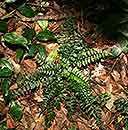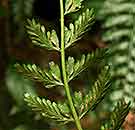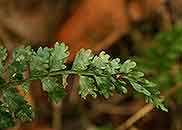Asplenium preussii Hieron. ex Brause
Synonyms |
Asplenium pseudoauriculatum Schelpe |
|---|---|
Common name |
|
Description |
Rhizome erect, up to 10 mm thick; rhizome scales 3-7 x 2 mm, brown, (sub)entire, subulate, hair-tipped. Fronds tufted, arching, thinly coriaceous, proliferous near the apex, the apical segment above the proliferating bud has more than 5 lobes. Stipe up to 20 cm long, stipe and rhachis sparsely set with dark brown scales, up to 2 mm long. Lamina 22-43 × 4.5-13 cm, 2-pinnatifid, lanceolate to narrowly elliptic in outline, basal pinnae hardly reduced. Pinnae up to 8.5 x 2 cm, petiolate, with 6 or more basiscopic pinnae lobes; the first arising between the 1st-2nd acroscopic lobes. Pinnae variable, from shallowly incised to strongly pinnatifid into narrow simple bifid lobes, basal lobe pointing towards the apex free, 4-fid and larger than the other lobes. Rhachis matt-greyish-green with minute dark brown scales. Sori one per lobe, linear, set along the veins, 2-7 mm long, slightly curved; indusium very narrowly oblong, membranous, entire. |
Notes | Confused with A. dregeanum; A. preussii has the first basal lobe arising between the 1st and 2nd acroscopic lobes. |
Derivation | preussii: named after Paul Rudolf Preuss, botanist, horticulturist, first director of Botanic Gardens at Victoria in Cameroon. |
Habitat | Moist evergreen forest. |
Distribution worldwide | See African distribution. |
Distribution in Africa |
Burundi, Cameroon, Congo, Dem. Republic of Congo, Equatorial Guinea (incl. Bioko), Ethiopia, Guinea, Kenya, Liberia, Malawi, Mozambique, Nigeria, Rwanda, Sierra Leone, South Africa, Sudan and South Sudan, Tanzania , Uganda, Zimbabwe. |
Growth form |
Epiphytic, lithophytic, terrestrial. |
Literature |
|




